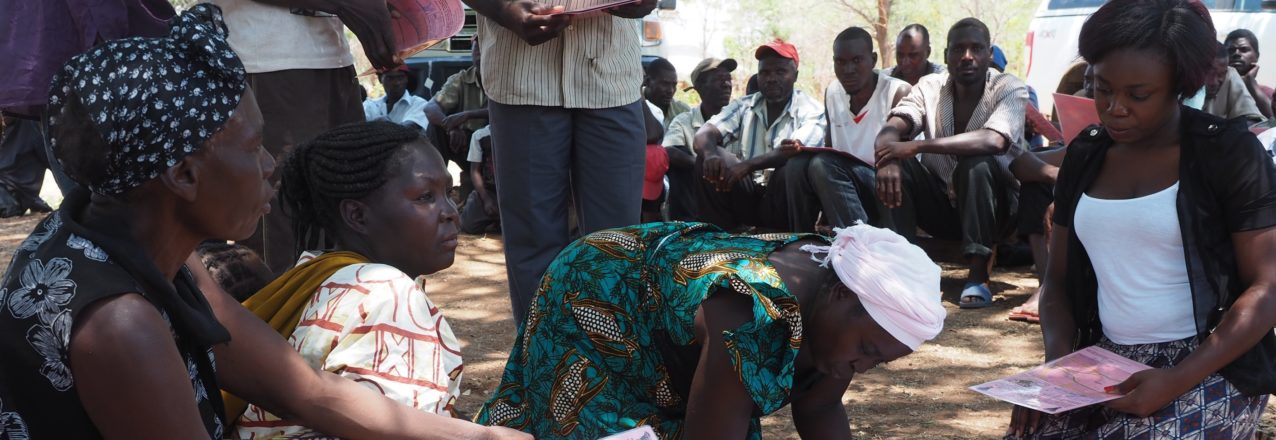INTEGRATED LAND AND RESOURCE GOVERNANCE TASK ORDER UNDER THE STRENGTHENING TENURE AND RESOURCE RIGHTS II (STARR II) IDIQ
INTRODUCTION
Governance (ILRG) program’s Gender Integration Strategy to project objectives and activities in Zambia and Mozambique pertaining to four areas: (1) documentation of customary/community land rights; (2) administration of customary/community land rights; (3) land use planning; and (4) governance of forestry and wildlife resources. The findings of this report will be integrated into each annual work plan and as new grantees and implementing partners are brought onto the project. Each country’s gender advisor will also use this assessment as a basis for their own work planning activities on a quarterly basis. The assessment will be built upon through time, as the management and technical team periodically review the report to ensure that principles and activities are actively integrated. Toward this end, the project works with governments, communities, civil society and the private sector.
The primary source of data for the assessment relates to work that was previously done under the Tenure and Global Climate Change (TGCC) program in Zambia and the Responsible Investment Pilot in Mozambique, which focused largely on customary/community land rights documentation. The assessment is therefore weighted toward this area of ILRG focus. This work builds on gender analysis previously conducted on TGCC activities in Zambia, and land and resource governance more generally in the project areas.1 The assessment is forward-looking, intended to inform practical steps that can be taken by ILRG staff and implementation partners to ensure a robust integration of the gender strategy and to flag urgent and important issues for follow-up. The assessment is limited in scope by time. With only one week in each country, spread between the respective capital cities and three project sites, the assessment team did not attempt to do deep substantive research, but rather to gain enough knowledge as quickly as possible to identify and begin to explore risks and opportunities moving forward. Finally, not every fact or impression captured in the assessment is presented in this report; rather the author seeks to condense findings and recommendations to those of highest priority and potential impact.
Specific objectives of this assessment include:
- To gain a more thorough understanding of impediments to women’s equal participation in land and resource governance, and rights to land and resources, within the project communities, and how the project can address these over time.
- Using the ILRG gender strategy as a guide, to identify gaps in gender equality in processes and outcomes related to planned project components and activities (with emphasis on the year one work plan), and provide strategies for addressing these.
The year one work plan provides little guidance on how to implement the project objectives in a way that equally includes and benefits both women and men. Per the ILRG gender strategy, access points for working on gender within the work plan are many. The challenge is to identify the combination of channels and approaches that will best foster gender equitable processes and outcomes and, at the very least, ensure that the project does not further entrench gender-biased social norms that continue to keep women and other vulnerable groups in the cycle of poverty. The assessment recommendations take note of the need to balance robust gender integration with efficiency of process.
During the course of the assessment, the project team had an opportunity to discuss in more detail the gender vision for the project, coming up with three working priorities. These incorporate a broad range of project values and guide the substance of this report, particularly the recommendations.
- Do no harm. The first objective for the project’s gender-related work is that we do not further entrench existing inequities through project design and activities. Given the high level of existing gender bias related to land and natural resource rights and governance in the project areas, and the lack of specific national expertise on gender in the project teams,2 there is a very serious risk that ILRG and other land rights documentation/recognition/ formalization projects will lock into place a gender-biased cultural approach at a time when cultural and social norms and trends are actually in great flux, due to urbanization, globalization, breakdown of traditional household and community institutions and traditions, and swiftly changing demographic patterns. The United States Agency for International Development (USAID) is not a passive bystander, but is rather actively engaged in formalizing rights and moving toward commoditization of rights to land and natural resources through ILRG and other programs. What if the outcome is that women are disproportionately locked out of the benefits? What is the impact of that now? In ten years? For future generations? It is of urgent importance to identify at the outset what steps can be taken to mitigate and address these risks.
- Support gender champions within the project areas. Some key leaders in both customary and state institutions within the project areas are already committed to gender equitable land and natural resource governance and have been working to strengthen women’s land rights. These include particular chiefs and chieftainesses, headmen and headwomen, leaders of farmer cooperatives, and certain local officials. The project will seek ways to support these champions, leveraging their voice for broader awareness and potential behavior change within a culturally appropriate framework.
- Provide space, time, and mechanisms within project areas for positive social changes related to gender to take place alongside project activities, and to be reflected in activities and outcomes. It will be important to make sure that gender-related dialogues around land and natural resource governance are taking place within communities3 that allow for organic shifts and changes around gender to take place, and for these to be reflected in project implementation.
The remainder of the report contains a short methodology section, followed by a section on findings in both Zambia and Mozambique, and concluding with a section on recommendations. The report has two annexes; one on legislative and policy issues for follow-up, and a second on issues for further data analysis.


